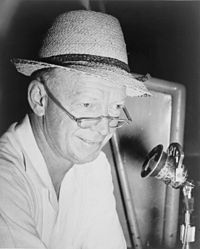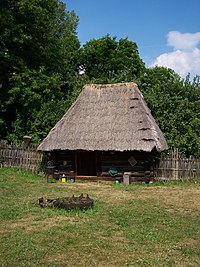Leo Baeck
Leo Baeck | |
|---|---|
 Bust of Leo Baeck at the Wiener Library for the Study of the Holocaust and Genocide in London, UK | |
| Personal | |
| Born | 23 May 1873 |
| Died | 2 November 1956 (aged 83) |
| Religion | Judaism |
| Spouse | Natalie Hamburger |
| Denomination | Reform Judaism |
| Synagogue | Fasanenstrasse Synagogue |
| Semicha | Hochschule für die Wissenschaft des Judentums |
Leo Baeck (23 May 1873 – 2 November 1956) was a 20th-century German rabbi, scholar, and theologian. He served as leader of Reform Judaism in his native country and internationally, and later represented all German Jews during the Nazi era. After the Second World War, he settled in London, in the United Kingdom, where he served as the chairman of the World Union for Progressive Judaism. In 1955, the Leo Baeck Institute for the study of the history and culture of German-speaking Jewry was established, and Baeck was its first international president. The Leo Baeck Medal has been awarded since 1978 to those who have helped preserve the spirit of German-speaking Jewry in culture, academia, politics, and philanthropy.[1]
Early years
Baeck was born in Lissa (Leszno) (then in the German Province of Posen, now in Poland), the son of Rabbi Samuel Baeck and his wife Eva (née Placzek). He began his education at the Jewish Theological Seminary of Breslau in 1894. He also studied philosophy in Berlin with Wilhelm Dilthey. He served as a rabbi in Oppeln (now Opole), Düsseldorf, and Berlin. He also taught at the Hochschule für die Wissenschaft des Judentums (Higher Institute for Jewish Studies).
In 1905 Baeck published The Essence of Judaism, in response to Adolf von Harnack's What is Christianity?. This book, which interpreted and valorized Judaism through a prism of neo-Kantianism tempered with religious existentialism, made him a famous proponent for the Jewish people and their faith. During World War I, Baeck served as a chaplain in the German Imperial Army.
Nazi persecution and deportation
In 1933, after the Nazis took power, Baeck worked to defend the Jewish community as president of the Reichsvertretung der Deutschen Juden, an umbrella organization that united German Jewry from 1933 to 1938. After the Reichsvertretung was disbanded during Kristallnacht in 1938, the Nazis reassembled the council's members under the government controlled Reichsvereinigung. Baeck headed this organization as its president until his deportation. On 27 January 1943, he was deported to the Theresienstadt concentration camp.
Baeck became the "honorary head" of the Council of Elders (Judenrat) in Theresienstadt. As such, he was protected from transports and with his protection list, could also save his relatives from transports,[2] among others his grand-niece Ruth (b. 1925). Moreover, Baeck became "prominent", which meant that he had better accommodation, better food and could receive mail more often.[3]
Hannah Arendt in her 1963 book Eichmann in Jerusalem examined Jewish cooperation with the Nazi authorities during the Holocaust, and names Baeck as one of those functionaries who withheld the truth from their communities of the end awaiting them, believing it more "humane" to bear the secret since "living in the expectation of death by gassing would only be the harder". Baeck, according to Arendt, also thought the existence of a Jewish police force within the camps would render the "ordeal easier" whereas in her view they turned out to be more brutal.[4] Auschwitz escapee Siegfried Lederer testified to Baeck about the death camp, but Baeck believed that revealing the truth to the Theresienstadt prisoners could cause "catastrophe".[5]
He gave lectures, was active in the interfaith dialogue between traditional Jews and Christians of Jewish origin, worked in the youth care sector, which he directed from November 1944 on, and was friendly with many of the functionaries. After liberation, he headed the Council of Elders; the last Elder of the Jews was the Czech communist Jiří Vogel.[6] Baeck's lectures were credited with helping prisoners survive their confinement. Heinrich F. Liebrecht said Baeck's lectures helped him to discover wellsprings of strength and the conviction that his life had a purpose. "From here came the impulse to really endure, and the belief that we were able to do so."[7]
그가 추방될 때까지 수많은 미국 기관들은 그가 전쟁에서 탈출하여 미국으로 이민을 갈 수 있도록 도와주겠다고 제안했다.[citation needed] 백씨는 자신의 지역사회를 포기하기를 거부했고 그 제안을 거절했다.[citation needed] 그럼에도 불구하고, 그는 그의 자매 중 세 명이 빈민가에서 죽었지만, 홀로코스트에서 살아남을 수 있었다.[8]
전후 생활과 일
전쟁이 끝난 후, 백은 런던으로 이주했고, 그곳에서 템플 포춘의 북서부 개혁 회당 총재직을 수락했다. 그는 미국의 히브리 유니언 대학에서 가르쳤고,[9] 결국 진보 유대교를 위한 세계 연합의 의장이 되었다. 이 시기에 그는 두 번째 주요 작품인 'This People 이스라엘'을 출판했는데, 그는 나치에 의해 수감되는 동안 부분적으로 펜을 썼다. 그의 종교간 업적이 늘어난 것은 그가 기독교, 예수, 바울의 건국 인물인 유대교를 개종하고 어느 정도 개간했다는 것을 의미하기도 했다.[10]
그는 1956년 11월 2일 영국 런던에서 사망했다.
국제레오백 연구소
1955년 독일어를 사용하는 유대인의 역사와 문화를 연구하는 레오 백 연구소가 설립되었으며, 백 연구소는 이 연구소의 초대 국제 총장이 되었다. 이 연구소는 현재 뉴욕 리오 백 연구소와 런던 리오 백 연구소를 포함한 전 세계 지부를 포함하고 있다.
호주 멜버른에 있는 Leo Back Centre for Progressive Judaism을 포함하여 모든 거주 대륙에 Leo Back의 이름을 딴 기관들이 있다.[11]
소행성 100047 레오백크는 그의 영예에 따라 이름이 지어졌으며, 런던의 개혁/진보적 랍비니컬 대학인 레오 백 칼리지도 그렇다.
참고 항목
참고 문헌 목록
- 베이커, 레너드(1982) 허트 데어 버폴그텐: 레오 백크는 드리튼 라이히야. 슈투트가르트: Klett-Cotta. ISBN3-12-930760-5(독일어).
- 베이커, 레너드 (1978년). 슬픔과 고통의 나날: 레오 백과 베를린 유대인 뉴욕: 맥밀런. ISBN 0-02-506340-5.
- 네이마크, 앤 E. (1986) 한 사람의 용맹함: 레오 백과 뉴욕 대학살 P. 더튼, ISBN 0-525-67175-7 (청소년 관객용)
- Friedlander, Albert H. Teacher of Theresienstadt, Overlook Press; Reprint (July 1991), ISBN 0-87951-393-4 (10), ISBN 978-0-87951-393-1.
- Heuberger, Georg and Backhaus, Fritz (2001). Leo Baeck 1873–1956: Aus dem Stamme von Rabbinern, Frankfurt: Jewish Museum. ISBN 3-633-54169-1.
- Homolka, Walter and Füllenbach, Elias H. (2008). Rabbiner Leo Baeck. Ein Lebensbild, Teetz / Berlin (= Jüdische Miniaturen, vol. 75). ISBN 978-3-938485-84-2.
- Meyer, Michael A. (2020). Rabbi Leo Baeck: Living a Religious Imperative in Troubled Times. University of Pennsylvania Press. ISBN 978-0-8122-5256-9..
References
- ^ "Honors". Leo Baeck Institute.
- ^ Adler, Hans Günther (2004). Theresienstadt 1941–1945 (in German). Göttingen: Wallstein Verlag. ISBN 978-3-89244-694-1., p. 287
- ^ "Theresienstadt Lexikon – Prominente" (in German). ghetto-theresienstadt.de. Retrieved 13 September 2011.
- ^ Hanna Arendt, Eichmann in Jerusalem, (1963) Viking Press 1965 pp. 118–119.
- ^ Kárný, Miroslav (1997). Die Flucht des Auschwitzer Häftlings Vítězslav Lederer und der tschechische Widerstand [The Escape of Auschwitz Prisoner Vítězslav Lederer and the Czech Resistance]. Theresienstädter Studien und Dokumente (in German). p. 168. ISBN 978-80-200-0614-1. OCLC 937213148.
- ^ Adler, Hans Günther (2004). Theresienstadt 1941–1945 (in German). Göttingen: Wallstein Verlag. ISBN 978-3-89244-694-1.
- ^ "Not To Hate..." Archived 2012-04-07 at the Wayback Machine The Times-Standard, Eureka, California (June 23, 2009). Retrieved October 19, 2011
- ^ Friederike Feldmann, Rosa Mandl and Elise Stern
- ^ "Dr. Leo Baeck Arrives in U.S.; Reform Rabbis Oppose Government Aid to Religious Bodies". JTA. 26 October 1949. Retrieved 17 December 2015.
- ^ Langton, Daniel (2010). The Apostle Paul in the Jewish Imagination. Cambridge University Press. pp. 63–65, 84–86. ISBN 9780521517409.
- ^ "Leo Baeck Centre for Progressive Judaism". Retrieved 17 December 2015.
External links
- Documents about Leo Baeck in the collection of the Jewish Museum Prague



